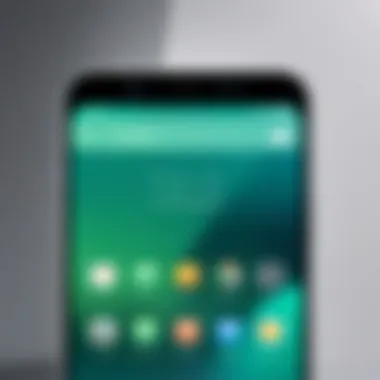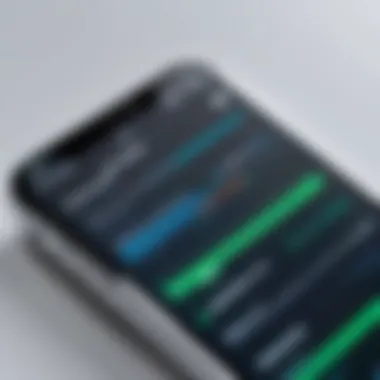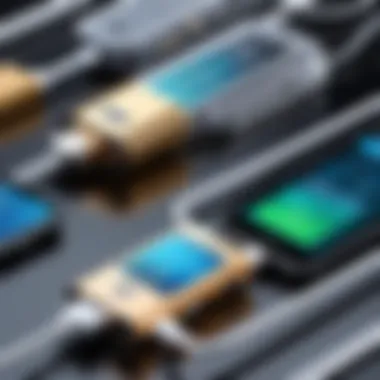Transfer Data from Android to iPhone: Complete Guide


Intro
Switching from one mobile operating system to another can be daunting, especially when it comes to transferring data. For many users, moving from an Android device to an iPhone raises questions about how to ensure a smooth transition. Given that both platforms operate differently, the potential for complications in data migration is significant. This guide aims to provide a well-structured overview of the processes and strategies to effectively transfer data between these two ecosystems.
Understanding the differences in file systems, data storage options, and available tools is essential for anyone looking to make the switch. In the following sections, we will delve into the necessary preparations, various methods for data migration, potential issues, and helpful tips to enhance your experience. Our goal is to equip users with the tools and knowledge they need for successful data transfer, minimizing the stress that often accompanies such changes.
By the end of this guide, you should feel confident navigating the complex landscape of transferring data from an Android device to an iPhone. Each section will build upon the last, culminating in a comprehensive understanding of how to handle your data with care during the migration process.
Understanding the Need for Data Transfer
In a world dominated by technology, the ability to seamlessly transfer data between devices is paramount. This holds even more significance when transitioning from an Android device to an Apple iPhone. Many users find themselves in a position where they need to shift their data due to a variety of reasons. Upgrading to a new device, enhanced features, or simply a desire for a different user experience may lead to this transition.
Understanding the need for efficient data transfer can enhance the overall user experience and simplify what often seems like a daunting task. The importance of this topic lies not just in the transfer itself but in the broader implications it has on a user's connection with their data, apps, and contacts.
The Shift from Android to iPhone
The migration from Android to iPhone can be driven by many factors. Some users seek the premium build quality and user-centric design of Apple devices. Others are drawn to the iOS ecosystem for its perceived stability and seamless integration with other Apple products. The shift can be exciting yet overwhelming. It is essential to understand that the transfer process is not merely a routine chore; it’s a critical step that determines how quickly and effectively users can adopt their new device.
Users must recognize that there are tangible benefits to organizing and transferring data properly. It ensures that personal and professional contacts, crucial notes, and cherished media remain intact. Each piece of data is part of the digital identity that users have cultivated over time. Therefore, taking the necessary preparatory steps is vital to preserving this digital legacy.
Importance of Data Migration
Data migration encapsulates much more than simply copying files from one device to another. The transition involves transferring vital information, applications, settings, and preferences that define how users interact with their devices. Effective migration leads to continuity in usage patterns, relieving anxiety associated with the transition.
The importance of data migration can be understood through several perspectives:
- User Experience: A successful data transfer enables users to maintain their workflow without disruption. Access to contacts, messages, and important documents should carry over seamlessly.
- Emotional Connection: Many users have sentimental attachments to media and messages. Retaining these records is important for maintaining a sense of continuity.
- Professional Necessities: For working professionals, uninterrupted access to data is critical. Employers may emphasize compliance with data security and transfer standards.
Given these factors, it is clear that understanding the nuances of data transfer is essential. It not only impacts the immediate experience of switching devices but also influences long-term satisfaction with the new platform. Users who grasp the significance of these processes can navigate the complexities of migration with greater confidence and control.
"In the digital age, data is as valuable as currency; it should never be lost in transition."
Thus, a comprehensive approach to data transfer facilitates not just a better transition but the future relationship one will have with their technology.
Preparing for the Transfer
Preparing for the transfer of data from Android to iPhone is a critical step that ensures a smooth transition between devices. This phase involves taking stock of what data you need to move and the methods available for transferring that data. Effective preparation minimizes the chances of data loss and reduces potential frustrations during the migration process. It is essential to conduct this preparation thoroughly to guarantee a seamless shift to your new iPhone.
Assessing Your Data Needs
Understanding your data needs is the first step before any transfer begins. Take a moment to evaluate what information holds significant value for you. Common categories include contacts, messages, photos, and app data. By listing out these items, you’ll have a clearer vision of what to focus on during the transition. This assessment not only informs your transfer strategy but also prioritizes the most important data for migration.
Backing Up Data on Android
Backing up your data on Android devices can significantly mitigate the risks of data loss. You have two main options for backing up: cloud backup and local backup methods.
Cloud Backup Options
Cloud backup options offer a convenient way to secure your data on Android devices. Services like Google Drive, and Samsung Cloud present easy solutions for data storage. The key characteristic of these cloud services is accessibility; your data is stored online and can be retrieved from any device with internet access.
This flexibility makes cloud backup a popular choice among users. A unique feature of cloud options is that they usually sync automatically, ensuring your most recent data is always saved without manual intervention. However, this method does require a stable internet connection and is dependent on the security of the cloud service used.
Local Backup Methods


Local backup methods offer a direct way to store data on physical devices. Users often utilize USB cables and computer software like Android File Transfer or Samsung Smart Switch. The key characteristic of local backups is control; you decide what to back up and where to store it. This option is increasingly beneficial for those wary of cloud security.
However, local backups do require a bit more effort, as you need to manage the storage devices and ensure they are functioning. Additionally, this approach does not protect data from device theft or damage.
Updating to the Latest Software
Keeping your Android device updated with the latest software is necessary before any data transfer. Outdated systems can hinder compatibility with migration tools and methods. Ensuring that your device has the latest updates can improve functionality, enhance security, and resolve bugs that could affect the transfer process. Always check for system updates in the settings menu to help facilitate a smoother migration.
Methods for Transferring Data
Data transfer between devices plays a critical role in ensuring continuity, convenience, and user satisfaction. The methods utilized for transferring data from Android to iPhone must reflect effectiveness and reliability. In this section, we explore several approaches, each with unique benefits and considerations. The right choice can significantly ease the transition, preserving essential data such as contacts, messages, and media. With the right information, individuals can select the method that best suits their needs.
Using Apple's Move to iOS App
Installation Process
The Move to iOS app is Apple's official solution for easy data migration. Its installation process is straightforward. Users need to download and install the application from the Google Play Store on their Android device. Once the iPhone is powered on and the setup process begins, the Move to iOS app can be accessed. The installation highlights its intuitive interface, guiding users seamlessly through each step.
This app's unique feature is its ability to transfer a variety of data types, including contacts, message history, and images. The benefit of using this app is its integration with Apple's ecosystem, making the process secure. However, it requires both devices to be on the same Wi-Fi network, which can pose challenges in some situations.
Step-by-Step Data Migration
Once the Move to iOS app is installed, the data migration is a systematic process. Users are prompted to enter a unique code displayed on the new iPhone, establishing a direct connection. The Step-by-Step Data Migration process allows for granular control over what data is transferred. It is beneficial because it helps avoid cluttering the new device with unwanted apps or files.
Key characteristics include the ability to transfer app data as well as essential media files. The unique feature of this method is its ease of use, which can greatly enhance the user's experience. On the downside, not all apps may transfer, which means users might have to find and download replacements manually.
Manual Transfer via Computer
Using iTunes
iTunes has been a traditional choice for many users when transferring data to an iPhone. Users connect their Android phone to a computer and use iTunes to sync data to the new device. This method allows users to preselect data types like music, photos, and videos.
A significant advantage of using iTunes is its ability to create a backup of existing data before the migration. This characteristic provides peace of mind. However, it can be complex for less tech-savvy individuals due to synchronization settings. Users must be cautious; a mistake could overwrite existing data on their iPhone.
Using Third-party Software
There are many third-party software options available designed to facilitate data transfer. Programs like MobileTrans allow users to move data directly between devices without complicated setups. This choice appeals to users seeking a fast and user-friendly solution.
The key characteristic of using third-party software is its flexibility, supporting various file formats and types. Many of these applications enable selective file transfer, allowing users to manage their data better. However, compatibility issues sometimes arise, and not all software guarantees complete security for sensitive information.
Transferring Data via Cloud Services
Google Drive
Google Drive provides an accessible solution for transferring data through cloud storage. Users can back up their data on the Android device and then download it from Google Drive onto the iPhone. This method is particularly appealing due to its convenience, requiring only an internet connection.
A significant feature of Google Drive is its ability to synchronize files continuously across devices. This helps ensure the most recent versions of documents and photos are available. However, users should be mindful of storage limits on free accounts, leading to potential costs if extensive data is involved.
Dropbox
Dropbox functions similarly to Google Drive by providing cloud storage for file transfer. Users can upload data from their Android device and later access it on their iPhone. This method is especially useful for multimedia files.
The distinguishing characteristic of Dropbox is its user-friendly interface. The application often boasts strong collaboration features. One downside is that Dropbox's free tier offers limited storage space, which could hinder larger data migrations.


Other Cloud Solutions
Numerous other cloud solutions exist that can facilitate data transfer. Services like OneDrive, Box, and iCloud can also assist in migrating data. Each of these platforms has its strengths, often offering specific features like extensive file format support or enhanced security.
The main consideration when opting for other cloud solutions is potential integration issues with iPhone. Selecting an appropriate service can streamline the process. However, it may necessitate adjusting to different applications and layouts, which could be slightly inconvenient for users accustomed to a particular platform.
Common Data Types to Transfer
When switching from Android to iPhone, understanding the common data types that need to be transferred is essential. Each data type holds unique significance and reflects personal and professional life. Recognizing their importance can aid in ensuring a smooth transition to your new device. This section will delve into four primary types of data that users typically consider: contacts, messages, photos and videos, and apps with their associated data.
Contacts
Contacts form the backbone of personal networks and professional connections. Transferring these details is often a priority for users. Every connection, from colleagues to friends and family, is stored here. Without successfully migrating contacts, reaching out to important individuals becomes more challenging. Moreover, missing important contacts can lead to communication gaps, impacting both personal and work-related interactions. Utilizing methods like Apple's Move to iOS app or cloud services can simplify this process greatly.
Messages
Messages often encapsulate significant moments, reminders, and decision-making cues in our lives. When transferring to a new platform, the loss of text messages can feel like losing a part of one’s history. Migrating messages ensures that conversations, especially those with sentimental value, remain accessible. By utilizing available tools, users can retain their messages, providing continuity in communication without starting from scratch.
Photos and Videos
Photos and videos are more than just files; they represent memories and experiences. These materials often hold emotional value and significance. Users should prioritize moving their galleries during a device transition. Failing to transfer cherished images could result in permanent loss of important life events. Using cloud services, like Google Drive, can facilitate easy migration of these valuable visual assets without requiring excessive effort from the user.
Apps and App Data
Apps have become central to how we interact with technology. They facilitate tasks and can contribute to productivity, entertainment, and even social interactions. Transferring apps along with their associated data ensures that the user experience remains consistent. Some apps offer cloud sync features, while others may need manual data transfers. Ensuring compatibility and checking settings after migration will enhance the usability of each new app on your iPhone.
In summary, effectively managing these data types—contacts, messages, photos and videos, and apps—is vital for a seamless transition from Android to iPhone. Planning and utilizing appropriate tools can help users retain their essential information, allowing them to continue their routines without significant disruption.
Troubleshooting Common Transfer Issues
When moving data from an Android device to an iPhone, users may encounter various challenges. Identifying and solving these issues is crucial for a smooth transition. Understanding common transfer problems allows users to preemptively address them, ensuring valuable data does not get compromised in the process. This section covers key issues, outlines effective solutions, and delivers insights that will aid in troubleshooting during the transfer.
Connectivity Problems
Connectivity problems can arise during the transfer process, leading to frustration. These issues might stem from poor Wi-Fi signals or Bluetooth complications.
To combat these problems, ensure the following:
- Stable Internet Connection: Confirm your Wi-Fi network is stable. A weak signal can interrupt the transfer.
- Check Device Compatibility: Ensure both devices are powered on and within a reasonable distance from each other.
- Airplane Mode: Disable Airplane Mode on both devices.
If problems persist, restarting both devices can refresh their connection and often resolves any inconsistent behavior.
Compatibility Concerns
Compatibility is another significant challenge when transferring data. Each operating system has unique formats and protocols. Not all data types may transfer seamlessly across platforms.
Here are some critical considerations:
- File Formats: Some files may not be compatible with an iPhone. For example, certain Android apps may not have direct equivalents on iOS.
- App Data: Specific apps might not migrate their data. Users should investigate app-specific solutions or reconfigure settings on the new device.
- Data Limits: iPhones might impose size limits on transfers, particularly when moving large video files. If this is the case, consider breaking the data into smaller chunks for transfer.
Data Loss and Recovery Options
Data loss is a worrying prospect during any migration. Accidental deletions or corruption during transfer can lead to significant frustration. Addressing this concern involves several initial preventive measures.


- Back Up Before Transfer: Maintain a full backup of both Android and iPhone data before beginning the transfer process. This is your safety net.
- Data Recovery Apps: If data is lost during the transfer, various data recovery tools can assist in retrieving files. These applications may vary in effectiveness, so it is best to research suitable options before needing them.
- Contact Support: In case of serious issues, reaching out to customer support from Apple or the Android brand can provide tailored assistance based on specific problems faced.
"Staying prepared can significantly reduce stress during data transfers. Always have backups and know your options."
In summary, addressing connectivity issues, ensuring compatibility, and having a plan for potential data loss will make the transition more effective and efficient. By being proactive, users can minimize complications, moving from Android to iPhone with confidence.
Finalizing Your Setup
Once you have transferred your data from Android to iPhone, the next crucial step is finalizing your setup. This process ensures that your new device operates to your preferences. It involves not just restoring apps and data but also optimizing the settings for a seamless user experience. Proper finalization can lead to better performance and increased user satisfaction.
Restoring Apps and Data
Restoring your apps and data is an essential part of settling into your new iPhone. Most applications available on Android can be found in the iOS ecosystem. You will have to manually download these apps from the App Store. Some apps may allow you to sign in and retrieve any saved content or settings once installed. Others may require you to set them up anew.
To make this process easier:
- Compile a list of essential apps before starting the transfer.
- Check if certain apps require a premium subscription or separate purchase on iOS.
- Be aware that some apps might not have the same features or performance due to platform differences.
Data such as contacts and messages should already be migrated. Ensure that any app-specific data is accessed and restored after installation. This might incorporate settings, preferences, and saved states crucial for continuity in usage.
Adjusting Settings on Your New iPhone
After restoring your apps, adjusting the settings on your new iPhone is vital. iPhones come with a range of settings and features that differ significantly from Android. These settings can directly affect performance, battery life, and usability.
Focus on the following areas:
- Notifications: Customize how notifications behave for each app. Ensure you set up alerts according to your preferences. This includes sounds, vibration, and banner style.
- Privacy Settings: Review and adjust privacy options to secure your data. Apple offers comprehensive privacy controls that allow you to limit app access to sensitive information such as location and contacts.
- Display and Brightness: Alter display settings to improve battery efficiency or enhance visibility. Adjust features like True Tone and Night Shift for comfort during different times of the day.
- Battery Management: Take advantage of built-in battery optimization tools to manage battery health effectively. Features like Low Power Mode can extend battery life when needed.
Ending
Finalizing your setup is as important as the data transfer itself. It transforms your new iPhone from a simple device into your personalized smartphone. Neglecting this step may result in a less than optimal experience. By fully restoring your apps and making necessary adjustments to settings, you ensure that your transition from Android to iPhone is not only smooth but that your device works in alignment with your lifestyle and preferences.
Best Practices for Future Data Management
Data management is often overlooked until a significant issue arises, such as loss of important files or app data. Understanding best practices can help mitigate these problems. By implementing sound strategies, users can ensure that their information remains secure and accessible, fostering a smoother experience when transitioning between mobile platforms like Android and iPhone.
Adopting effective data management habits can be invaluable for tech-savvy individuals and gadget lovers. It can save time and reduce frustration. Additionally, these practices can contribute to maintaining optimal device performance. The following subsections explore two critical components of future data management: regular backups and utilizing cloud storage.
Regular Backups
Regular backups are essential. They provide a safety net for your data. By backing up your information routinely, you minimize the risk of losing vital data due to software issues or device failure. The approach to backups can vary, but consistency is key.
Users can choose from various backup methods. For instance:
- Cloud Backups: Services like Google Drive or Apple's iCloud offer automated backups. Users only need to ensure their devices are connected to the internet and have enough storage.
- Local Backups: Tools such as iTunes for iPhone or Android File Transfer enable users to make backups on their computers. This method is especially useful for extensive data transfers.
Establish a regular schedule for backups—be it weekly or monthly. Be sure to review the data included in each backup. This process ensures that you are not missing any recent files or app data.
Utilizing Cloud Storage Efficiently
Cloud storage has revolutionized how we store and share data. Its benefits extend beyond simple storage. Using cloud solutions wisely can enhance overall data management practices. Here are some ways to utilize cloud storage efficiently:
- Selective Uploading: Rather than uploading everything, consider which files are necessary. This practice saves space and makes it easier to find important documents.
- Organizing Files: Create folders for different types of data. Having a well-organized cloud storage structure aids in locating files quickly.
- Sharing Options: Use tools within your cloud service to share content with others easily. This capability is beneficial when collaborating on projects or sharing media with family and friends.
By integrating regular backups and efficient cloud storage use into your routine, you fortify your data management strategy. Staying proactive about these matters fosters a hassle-free user experience, particularly during transitions between platforms.
"Data management is not just about storage; it's about ensuring accessibility and security."
Following these best practices can lead to increased confidence when handling personal data. It allows you to easily manage transitions and collaborations while maintaining peace of mind about the security of your information.







